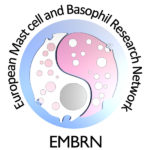Actin cytoskeleton in FcεRI signaling events in mast cells
Actin cytoskeleton has been implicated at early FcεRI-mediated signaling events as well as at later steps leading to degranulation and/or cell migration (1). In initial biochemical studies aggregation of the FcεRI caused rapid decrease in the amount of filamentous (F)-actin followed by its subsequent increase
